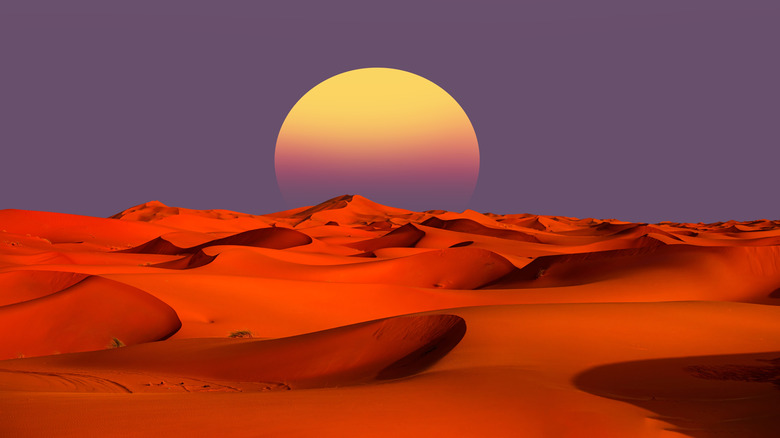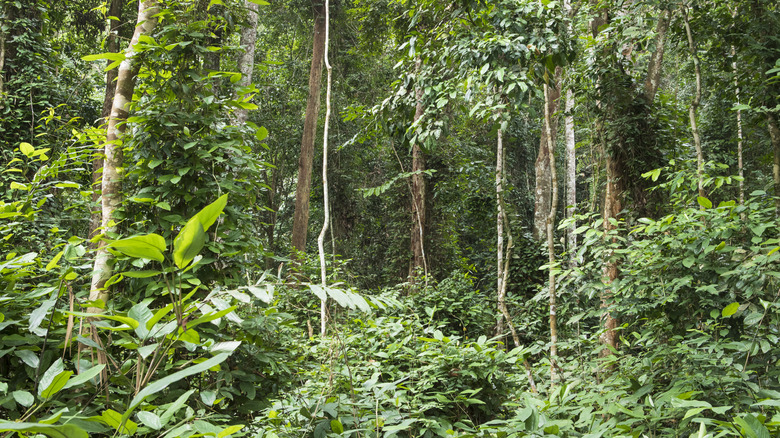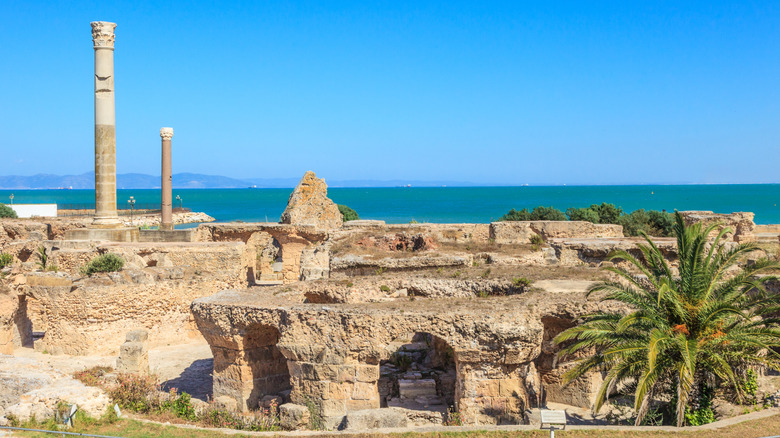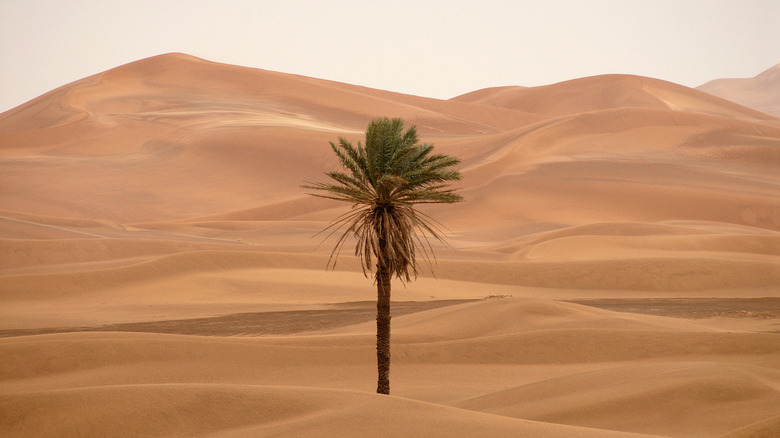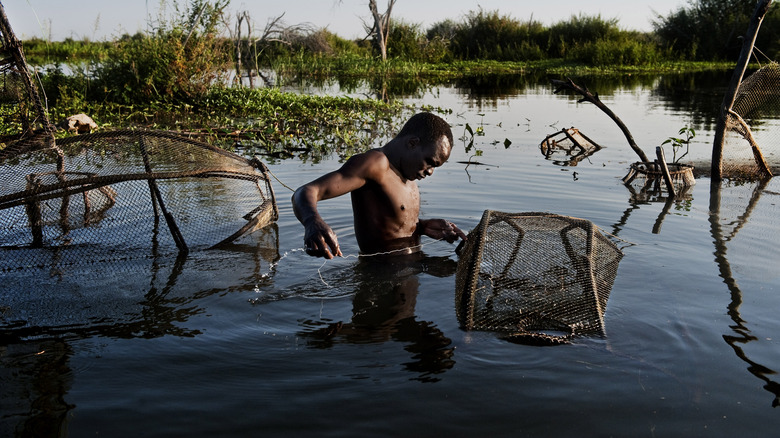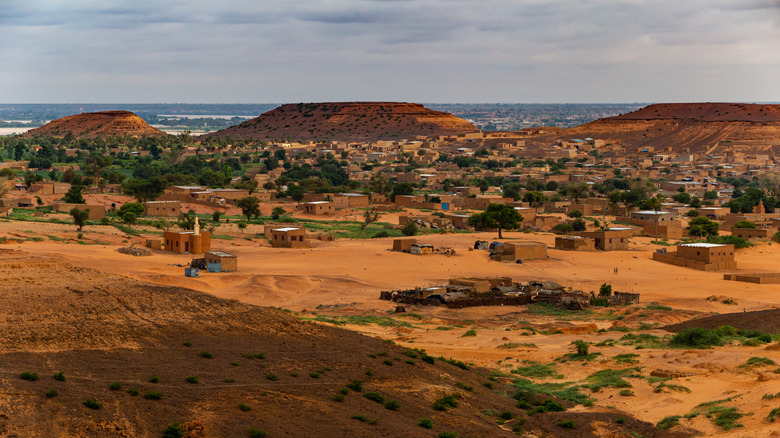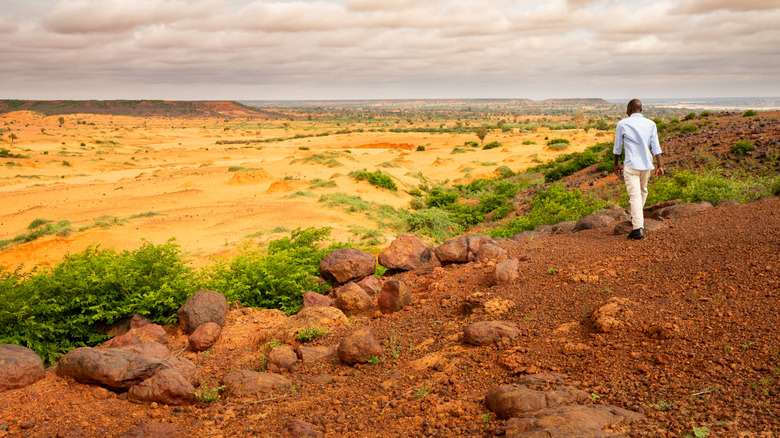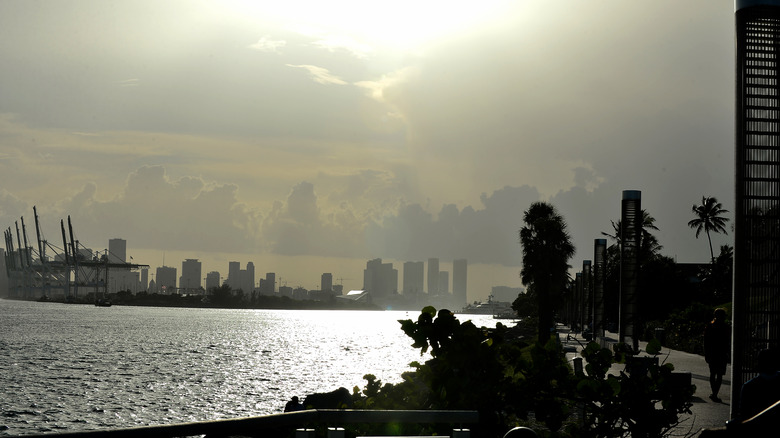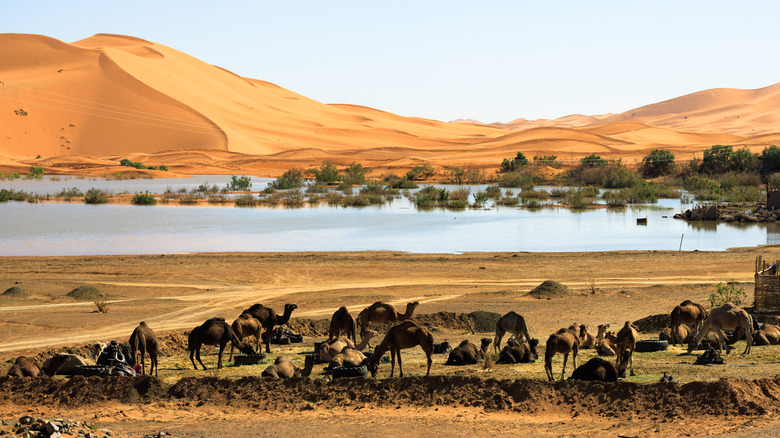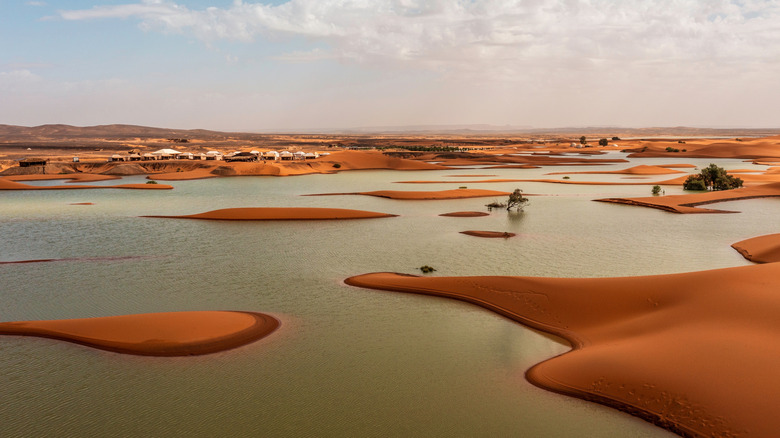The Sahara Won't Be A Desert Forever. Here's Why
Easily visible from space, North Africa's massive Sahara desert is one of Earth's most prominent geographical features. Measuring 3,000 miles from east to west and an average of 1,000 miles on its north-south axis, the 3,300,000 million square miles of the desert sprawl across parts of 11 or 12 countries, depending on how you feel about the Sahrawi Republic. It's the third largest desert in the world (after the cold deserts in Antarctica and across the northern polar region), and a quarter of it is covered with central-casting sand dunes. When you think desert, you think Sahara.
But Africa's arid north hasn't always been like this, and it won't always be like this. Long-term changes in the Earth's rotation mean Northern Africa isn't doomed to eternal dryness, and millennia from now, the Sahara will become wetter. In the meantime, human-caused climate change means the Sahara, just like the rest of the planet, is in for some short-term changes.
Big climate shifts can occur because of Earth wobbling on its axis
As most readers will hopefully accept, the Earth is a more-or-less sphere that spins on its own axis as it revolves around the sun. Each turn of the Earth on its axis makes up a single day, as the rotation exposes different regions to the light of the sun. This axis is noticeably tilted, meaning that at different times of the Earth's annual path around the sun, either the northern or southern half of the planet will temporarily be closer to the sun, causing the annual cycle of seasons.
This axis isn't perfectly fixed, though. The axis itself moves in a long, slow orbit (think about the stem of a spinning top drawing a lazy circle) in a process grandly called "the precession of the equinoxes," which results partly from gravitational tugs from the other planets in the solar system. One cycle takes over 25,000 years, so it's not something an individual human being lives long enough to notice. Whether we pay attention or not, the pole star will change over time, and so will the pattern of seasons and climate on Earth, given that the axis governing the seasons will be more or less angled in relation to the sun.
Depending on where the Earth is in this cycle of precession, rain patterns can alter from the ones we're familiar with now, with one response being a shift in African monsoons to bring more rain into the area where the Sahara now lies. This change is regular enough that scientist can observe it in geological records to check their models of past and future climate change.
Until about 5,000 years ago, there was a North African humid period
When the Earth's axis is placed so that North Africa receives more rain than it does now, it's referred to as a North African humid period — not the most thrilling name, but hey. Scientists formed a model of planetary climate based on what they knew about the Earth's precession, and when it predicted cyclical wet periods for North Africa, the scientists looked for confirmation. They got that validation by looking at marine cores, taken from areas of long-term sediment buildup that allow researchers to look at the layers like tree rings and examine them — and the occasional plant material found within them — for information.
The observed marine cores matched the model well, proving the cyclical nature of North African humid periods and indicating the model's ability to predict them. Occasionally, the real-world samples "skipped" an expected humid period, seemingly during ice ages when the ice exerted its own effect on the climate, but even those periods were wetter compared to the eras before and after them. In total, researchers were able to confidently identify 230 distinct North African humid periods in the marine cores they studied.
Surprisingly, these humid periods appear to occur when the axis's tilt makes North Africa hotter. The low air pressure created by the hot land pulls in the wet ocean air, allowing North Africa to be irrigated by seasonal monsoon rains. These rains were enough to maintain a number of lakes in North Africa during the last major humid cycle.
North Africa used to be wetter and more fertile in antiquity
The last North African humid period lasted from about 11,000 years ago to 5,000 years ago, ending well within human history. We also know that human beings took advantage of it: Travelers have found (and academics have studied) rock carvings made by prehistoric people in various sites in the Sahara, depicting what must have been a much greener environment. The images depict animals like giraffes, which no longer live in the region, as well as cattle herding. The carvings seem to have been made by various groups on rocks that would have formed notable points in the landscape, perhaps marking meeting places.
Even in recorded history, North Africa was wetter and more fertile than it is today. Two of the most agriculturally important provinces for the Roman Empire were Africa (which then referred to North Africa, not the whole continent) and Egypt. Much of Egypt's productivity came from the fertility of the Nile Valley, but small, dry Africa — the heartland of Rome's devoured enemy Carthage — produced so much food that it became Rome's most important supplier of grain and an important source of legumes, olives, oil, and pickled fish, as well as preserved fruit for those who could afford it.
This African grain became incredibly important to Roman order because it allowed Rome to provide cheap and later free food to its citizens. When the Vandals took over North Africa in the early fifth century, they were then able to use their control of this grain supply and the supply port at Carthage as an effective weapon of war against what remained of the Roman Empire. Nothing gold can stay, though, and modern Tunisia is a net importer of food products.
The Sahara has expanded through most of recorded history
Even though prehistoric people were able to herd cattle in the Sahara region and North African grain fed Rome for centuries, most of recorded human history has seen the Sahara Desert expand. This is due both to the precessionary cycle and to continental drift, which is slowly pulling Africa northward and affecting its rainfall. Deserts are more common in subtropics, with tropics usually being wetter, and this motion is pulling more land into the subtropical sweet spot. And as with almost every other natural cycle on Earth, climate changes caused by human activity are further disrupting the pattern, even if so far most of the Sahara's expansion can be attributed to natural cycles.
Since 1920, the Sahara has expanded by about 10 percent. Over the past century, the desert has advanced over 500 kilometers to the north across Libya, aridifying a country that wasn't always the mostly-desert state it is today. In Mali, the desert is advancing southward by 48 kilometers each year. And there's no reason the desertification has to stop at the Mediterranean. By 2100, some scientists project that conditions like those in the Sahara will extend into southern Europe and Asia Minor, dessicating parts of Turkey, Cyprus, Greece, Italy, and especially Spain and Portugal.
The drying of the Sahara has caused problems for societies on the desert's edges
The expanding Sahara has caused trouble for people in its path, as life on a grassland is very different (and easier) than life in a desert. One of the major casualties of the expanding desert is Lake Chad, a basin which has hosted human societies for over 2,500 years and is an important water source for millions of people today. Lake Chad has seemingly always varied in extent — its massive prehistoric incarnation is known as Mega-Chad — but with climate change as well as overuse by growing lakeside populations, it's getting smaller and smaller, and now its bed only covers about a 10th of the area it did in the 1960s. This reduction threatens the livelihood and water resources of the people who use it, especially since there aren't many other options in the drying Sahel region south of the Sahara.
Human beings have confronted desertification in this region before, of course, given that societies that lived in the last wet Sahara left traces of themselves. They moved, with some groups probably contributing to the development of Egypt and other societies on the reliable Nile, while others migrated south, bringing their animal-herding lifestyles with them to the rest of the continent. Whatever the modern equivalent of "moving south and teaching people how to herd goats" is, it may need to happen quickly: Over 10 million people in the Lake Chad basin already need humanitarian assistance just to survive.
People are trying to slow or stop the Sahara's spread
There are efforts to stop, or at least slow, the expansion of the Sahara Desert to give societies time to adapt. A particular focus is on the Sahel, the band of territory immediately south of the Sahara, which crosses the continent from Atlantic-facing Senegal to Eritrea and Djibouti on the Red Sea coast. "Sahel" is Arabic for "shore," implying an understandable depiction of the Sahara as a sandy sea. Changes in the semi-dry Sahel are straining food supplies and contributing to political instability in countries like Mali, Burkina Faso, and Niger.
An alliance of 11 affected countries came together to stop the Sahara behind a "Great Green Wall," with other countries later joining to bring the total to 22 nations. Land use problems like overgrazing are accelerating desertification, and so the Great Green Wall initiative hopes to address the issue of a drying landscape by involving local people in finding more sustainable solutions. There's a lot of tree planting, but that's far from the only aspect: Each of the participating countries is free to pursue its own version of the project's shared goals, with the hope of building a chain of restored, thriving landscapes from coast to coast through the Sahel that can withstand climate change and increase food security for the region's populations.
The Sahel, to the Sahara's south, is already getting wetter than in recent decades
During the 1970s and '80s, the Sahel saw one of the worst droughts of the 20th century, with average rainfall 30% lower than during the 1950s. Explanations for the drought have varied, including natural climate variation, human-driven climate change, or reactions to deforestation and land overuse in the region itself. In recent decades, rainfall has again increased.
It's hard to tell if a wetter Sahel is good news — or at least, if it's good news to stay. While climate modeling is almost by definition very difficult, a number of models show today's moister Sahel as a temporary reprieve, an anomaly as a warming ocean tweaks rainfall patterns and again dries the Sahel. Some models predict that by 2150, the late 20th-century drought will be far surpassed by stronger drying trends.
In the short term, the Sahel is heating up faster than much of the rest of the planet, and is set to pass the emotionally resonant threshold of two degrees Celsius of warming by 2040 at the latest. The skewing of weather could have complicated effects on the Sahel, drawing out the annual monsoon season and making both droughts and punishing floods more common. In an area where many people already lead tenuous, uncertain existences, this added unpredictability could easily worsen existing political and economic crises.
The Sahara is a major influence on current world climate
What happens to the Sahara happens to us all. Because it is so big, hot, dry, and dusty, the Sahara Desert has major effects on the climate around the globe. Some people may not remember the major Saharan dust storm of 2020, given that there was quite a bit going on that year, but dust from the Sahara crossed the Atlantic in such quantities that it irritated lungs and prettied up sunsets in Florida. This was just an extreme event, however: Saharan dust is frequently blown around and, beyond affecting weather, helps make the soil of the Amazon rainforests more fertile.
That dust is more than just the bane of committed housecleaners. Dust in the atmosphere can affect the amount and distribution of incoming radiation from the sun, as well as alter cloud formation (and therefore rain distribution). Saharan dust also has complicated effects on the formation of tropical cyclones, with some effects making them more likely to occur, while others tamp them down. Existing variations in the Sahara can already have noticeable effects on the amount of North African dust floating around, with periods of higher vegetation reducing the volume of dust and its altering effects.
Warming-driven rain events are wetting the Sahara more than before
The Sahara is currently getting a taste of its green past and future thanks to climate-change-driven rain anomalies. In September 2024, an extratropical cyclone on an unusual path dropped rain on Morocco, Algeria, Tunisia, and Libya, temporarily filling dry lakebeds and greening the landscape with a burst of optimistic vegetation, including in places that had not recently hosted plant life. Also in 2024, higher-than-usual rains soaked other parts of the desert, with particularly big increases in greenery in Chad, Sudan, and Eritrea.
It's tempting to see this as good news on an almost biblical scale, with the freshly irrigated desert turning lush and fruitful. While it's an inspiring visual, the sudden rains also undermined the one thing most essential to human thriving: predictability. Millions of people found themselves at risk of flooding, and the rains were not universal, meaning some areas found themselves in drought even as their neighbors sloshed around in the mud. While oases and other green pockets may develop from rain events like these, it's currently too soon to celebrate.
While some of the unusual rainfall had to do with the regular and expected El Nino / La Nina cycle of wind strength and water temperatures in the Pacific Ocean, climate change also played a role. As the planet heats, the expected latitudes where rain will develop are more likely to shift away from the equator, dumping precipitation on parched but unprepared parts of the world. One silver lining of this effect is that tropical waves may start coming off the African coast further north, limiting their chances to become hurricanes affecting the Americas.
A wet Sahara will return, be it through the usual cycling or climate change
One thing is certain: if there remains a recognizable Earth, the Sahara will become green again. During its last green period, the vast expanse we know as the queen of deserts was home to hippos and elephants as well as human societies, and no matter what damage we modern people do to the planet, its slow and mighty cycles will bring the rain back to this swathe of Africa. (Whether there will be anyone left to bless those rains remains to be seen.) Without greenhouse gases, this transition back to a green Sahara would occur sometime between A.D. 12000 and 13000. There's no real way to predict what our current high-emissions timeline would do to this estimate, though green Saharas seem to have occurred during previous periods of high atmospheric carbon levels.
Scientists think the last Sahara transition happened quickly, as climate shifts go, with the last wet Sahara drying out over the span of about 200 years; long compared to a human lifetime, but short for evolution or even the history of a nation. If any human beings remain in the long-distant future, they may, over the course of two or three long lives, witness the natural miracle of the desert bursting into life.
